The content of the article
The order of Lepidoptera, which is well known to us under the name butterflies, gathered the most amazing representatives of the class of insects. The beauty of these creatures made them admire many people on the planet. The admiral butterfly is no exception - the most striking example related to the nymphalidae family.
Usually, the attention of many people is attracted by the original marine, partly masculine name of a fragile and sophisticated insect. The history of its occurrence has a close relationship with mythology. It is known that a butterfly of this species was first discovered by the famous scientist Karl Linnaeus. The insect discovered by him was named Vanessa Atlanta, after the name of the daughter of one of the heroes of Ancient Greece Scheena. She was famous for her beauty, athletic physique and excellent running abilities. According to legend, Schemen wanted to have only male offspring, so he ordered the girl to be thrown into the abyss from a high mountain. Most of the life of the surviving girl was spent in the forest and filled with incredible adventures and trials. So, thanks to the biological discoveries of the researcher of the Renaissance, her name was immortalized not only in ancient Greek mythology, but also on the pages of textbooks.
Speaking about the origin of the common name Admiral, two stories are worth mentioning. The first is related to the translation of the word from Turkish. Meaning "owning the sea," it seems out of place for a butterfly found in land areas. However, scientists warn us and ask us not to make hasty conclusions. Since today the butterfly’s ability to make long flights, which are sometimes laid through sea spaces, has been recorded. The second version is more poetic. It is caused by the similarity of diagonal contrasting red stripes located on the dark background of the wing with the ribbons of the uniforms of the heads of the navy, captured by people.
Butterfly Description
The life of the admiral’s butterfly is consonant with the unusual nature of the name that it bears. However, we will come back to this issue later. Now we need to give an answer to another - what does the admiral butterfly look like?
The wingspan of the admiral's butterfly is on average 6 cm. Sometimes you can notice light spots at the top of the wings, consisting of three connected small ones. They are surrounded by specks of light shades of indeterminate shape, varying from time to time. The edges and the inside of the wings are brown. Acting as a contrasting background, it clearly highlights other details of the decoration. Such, for example, are a scattering of sea-green rings or a band running diagonally and painted in bright scarlet and orange. The same line seems to continue on the hind wings of an insect, rim passing along their outer edges. The corners of the hind wings are decorated with bluish ovals, outlined by a black rim.A close look at the back of the wings of the admiral’s butterfly will make new interesting discoveries. So, we will see that their entire area is decorated with mosaics from various colored parts: white and red, brown and gray.
The body of the butterfly is painted in dark colors, ranging from dark shades of brown to black. Perfectly distinguishing the slightest light vibrations and objects that are surrounded, the insect's eyes are located on the lateral parts of the head in the form of hemispheres. This optical fad, given to the butterfly by nature, allows you to visually perceive the amount of space without having to turn a sedentary head or eyes. Butterflies perceive various colors, among which there is blue, green, yellow. A famous exception to this ability is red, as they are not able to notice it.
The eyes of the butterfly are protected by small hairs. They have a mustache on their forehead with a small increase at the end, playing the role of the most important sensory organ for the insect. With the help of a mustache, they are able to distinguish smells over a long distance. At the bottom of the head is the proboscis, which performs the function of the mouth. If he does not work and is not busy with an important matter, then he rests, curled up in a spiral.
The chest part includes three units, each of which is equipped with the necessary limbs for movement. Forelegs have hairline. It is important for touch. The large wings of the admiral’s butterfly allow her to cover sufficient distances. The insect flies in order to look for a more suitable habitat for itself. So, often representatives of this species can be attributed to migratory.
Butterfly Distribution Range
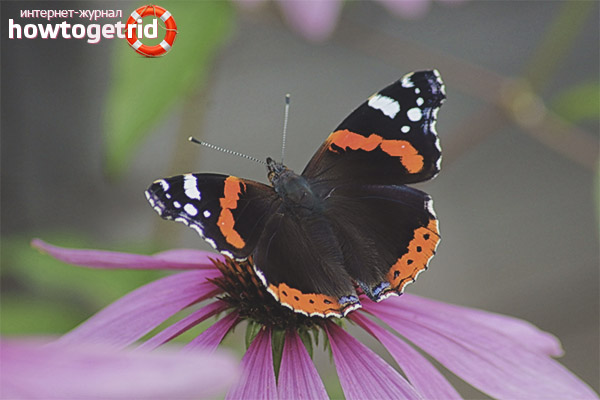
The habitat of the insect is Eurasia (part of it outside the tropics), islands on the Atlantic coast, as well as Northern Africa, Canada and the United States. Wherever the butterfly is located, in any case, it will go for wintering to the southern parts of its habitat. That is why this species is characterized by migrations, forcing individuals to travel huge distances. Scientists emphasize that often admiral butterflies fly to places where not every bird is able to fly. The death of many of them, overtaking individuals during migration, cannot be denied. However, the most hardy manages to achieve the goal, to lay out and die with a sense of accomplishment to nature. The offspring that came into the world and subsequently grows stronger are usually sent back in a year. Part of the population does not leave habitats for wintering, but tries to find a secluded place in crevices or under the bark. Awakening by the spring sun becomes a signal to leave the shelter. The color of individuals that survived the test of overwintering is often brighter and more colorful than those who just appeared to the world.
Migration of butterflies leads to the fact that the population in some areas is quite variable: some individuals leave one territory, which leads to a decrease in indicators in this place, but flies to another, where the numbers increase significantly.
On the territory of our country, insects live in the forests of the central regions and northwestern Karelia, as well as in the eastern part of the Caucasus and the Urals. If an individual lives in the mountains, then you can see it at an altitude of 2.5 km to 2.7 km. She lives on the forest edges or mountain meadows, she can be met both on the side of the highway, and wild lakes and rivers. In August, the admiral's butterfly does not deprive its attention of overripe berries and fruits, so summer residents admire the wonderful creation of plums and pears grown on their trunks. She is one of a small number of those Lepidoptera, which can be seen among the latter before the upcoming cold autumn weather. She reaches for the light of lights and the sweet nectar of flowers on warm summer days.Therefore, the mild European winter misleads graceful butterflies, because they can wake up ahead of schedule and die due to the sudden arrival of sunny days in the middle of the cold season.
Butterfly Varieties
There are two color options for individuals of this species. Each of them is characteristic of a particular subspecies. The first is an insect called the red admiral butterfly, whose calling card is an orange sling on black wings. The second species is the white general butterfly. Her color is characterized by black and white shades of flowers. Evolutionary processes and the need to protect themselves from predators gave individuals a similar camouflage color option. In addition, the butterflies of this subspecies are distinguished by the uniqueness and amazingness of a flight not characteristic of others: they are replaced by powerful waves with freezing in the air.
Admiral butterflies also have a related species - burdock or thistle, often called the pink admiral. They are similar in size as well as in behavior and distribution. The color of representatives of this species is distinguished by an orange-pink gamut of shades of decor.
Admiral butterfly is one of the most unique and unique species in Eurasia. In order to ensure that the number of individuals does not decrease, biologists call for the adoption of important protective measures. Information on the introduction of the species in the Red Book is not new. The rarity of the insect is due to thoughtless and massive destruction of forests, the widespread use of harmful and polluting substances and compounds.
How does a butterfly live and what does it eat?
What does the admiral butterfly eat? When it appears to the world in the form of a caterpillar, it feeds on nettles, thistles and many other plants. It is interesting that the leaves are important for the insect during this period both as a means of food and as a means of protection. Turning into a butterfly, she begins to eat the nectar of flowers. By the end of summer, fruits and berries become a treat for her.
An important part of the life of any organism is reproduction. Butterflies are insects with a full cycle of transformation. It begins with laying eggs, from which larvae are born. Subsequently, they turn into pupae, from which an adult comes out. The calculation is carried out by a female individual, conquered during the mating season by the male.
Video: Admiral Butterfly (Vanessa atalanta)

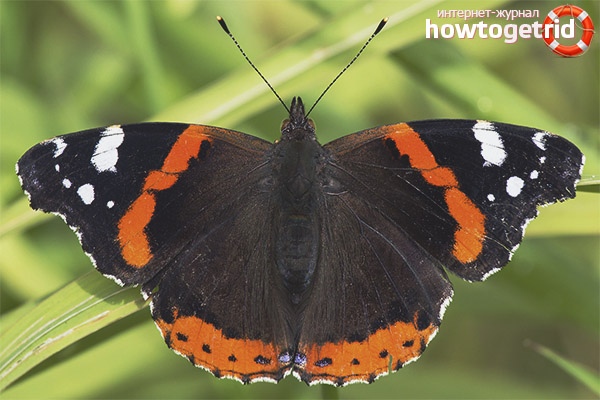
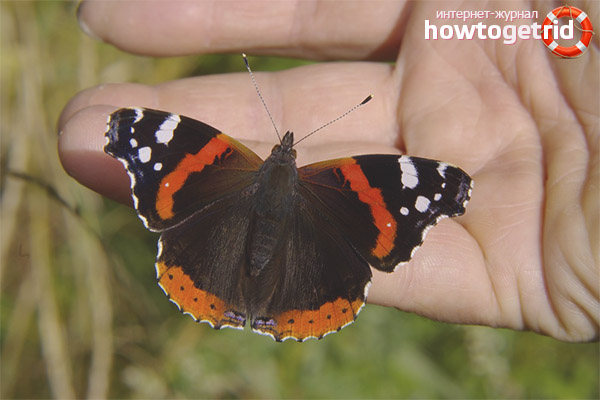
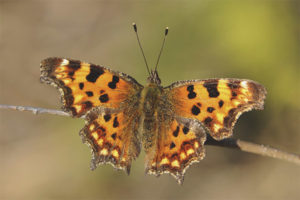

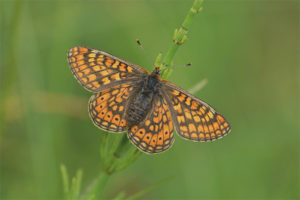



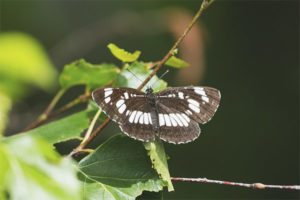
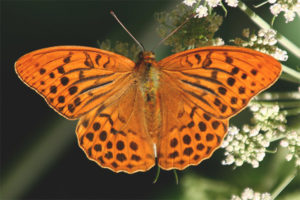
Submit